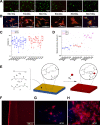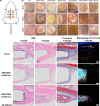Concomitant control of mechanical properties and degradation in resorbable elastomer-like materials using stereochemistry and stoichiometry for soft tissue engineering
- PMID: 33469013
- PMCID: PMC7815890
- DOI: 10.1038/s41467-020-20610-5
Concomitant control of mechanical properties and degradation in resorbable elastomer-like materials using stereochemistry and stoichiometry for soft tissue engineering
Abstract
Complex biological tissues are highly viscoelastic and dynamic. Efforts to repair or replace cartilage, tendon, muscle, and vasculature using materials that facilitate repair and regeneration have been ongoing for decades. However, materials that possess the mechanical, chemical, and resorption characteristics necessary to recapitulate these tissues have been difficult to mimic using synthetic resorbable biomaterials. Herein, we report a series of resorbable elastomer-like materials that are compositionally identical and possess varying ratios of cis:trans double bonds in the backbone. These features afford concomitant control over the mechanical and surface eroding degradation properties of these materials. We show the materials can be functionalized post-polymerization with bioactive species and enhance cell adhesion. Furthermore, an in vivo rat model demonstrates that degradation and resorption are dependent on succinate stoichiometry in the elastomers and the results show limited inflammation highlighting their potential for use in soft tissue regeneration and drug delivery.
Conflict of interest statement
A patent application was submitted in 2018 by M.L.B. and A.P.D. covering some aspects of this work.
Figures






Similar articles
-
Comparison of different three dimensional-printed resorbable materials: In vitro biocompatibility, In vitro degradation rate, and cell differentiation support.J Biomater Appl. 2018 Aug;33(2):281-294. doi: 10.1177/0885328218787219. Epub 2018 Jul 13. J Biomater Appl. 2018. PMID: 30004265
-
Fabricating poly(1,8-octanediol citrate) elastomer based fibrous mats via electrospinning for soft tissue engineering scaffold.J Mater Sci Mater Med. 2017 Jun;28(6):93. doi: 10.1007/s10856-017-5906-7. Epub 2017 May 15. J Mater Sci Mater Med. 2017. PMID: 28510114
-
Surface modifications of photocrosslinked biodegradable elastomers and their influence on smooth muscle cell adhesion and proliferation.Acta Biomater. 2009 Sep;5(7):2429-40. doi: 10.1016/j.actbio.2009.03.023. Epub 2009 Mar 27. Acta Biomater. 2009. PMID: 19375999
-
Biodegradable and biomimetic elastomeric scaffolds for tissue-engineered heart valves.Acta Biomater. 2017 Jan 15;48:2-19. doi: 10.1016/j.actbio.2016.10.032. Epub 2016 Oct 22. Acta Biomater. 2017. PMID: 27780764 Review.
-
Engineering of Bioresorbable Polymers for Tissue Engineering and Drug Delivery Applications.Adv Healthc Mater. 2024 Dec;13(30):e2401674. doi: 10.1002/adhm.202401674. Epub 2024 Sep 4. Adv Healthc Mater. 2024. PMID: 39233521 Free PMC article. Review.
Cited by
-
Sugar-Based Polymers with Stereochemistry-Dependent Degradability and Mechanical Properties.J Am Chem Soc. 2022 Jan 26;144(3):1243-1250. doi: 10.1021/jacs.1c10278. Epub 2022 Jan 14. J Am Chem Soc. 2022. PMID: 35029980 Free PMC article.
-
Click Step-Growth Polymerization and E/Z Stereochemistry Using Nucleophilic Thiol-yne/-ene Reactions: Applying Old Concepts for Practical Sustainable (Bio)Materials.Acc Chem Res. 2022 Sep 6;55(17):2355-2369. doi: 10.1021/acs.accounts.2c00293. Epub 2022 Aug 25. Acc Chem Res. 2022. PMID: 36006902 Free PMC article.
-
High-speed, scanned laser structuring of multi-layered eco/bioresorbable materials for advanced electronic systems.Nat Commun. 2022 Oct 31;13(1):6518. doi: 10.1038/s41467-022-34173-0. Nat Commun. 2022. PMID: 36316354 Free PMC article.
-
Resorbable barrier polymers for flexible bioelectronics.Nat Commun. 2023 Nov 11;14(1):7299. doi: 10.1038/s41467-023-42775-5. Nat Commun. 2023. PMID: 37949871 Free PMC article.
-
Hybrid Shear-thinning Hydrogel Integrating Hyaluronic Acid with ROS-Responsive Nanoparticles.Adv Funct Mater. 2023 Aug 1;33(31):2213368. doi: 10.1002/adfm.202213368. Epub 2023 May 1. Adv Funct Mater. 2023. PMID: 38107427 Free PMC article.
References
-
- Chen Q, Liang S, Thouas GA. Elastic biomaterials for tissue engineering. Prog. Polym. Sci. 2013;38:584–671. doi: 10.1016/j.progpolymsci.2012.05.003. - DOI
-
- Nair LS, Laurencin CT. Biodegradable polymers as biomaterials. Prog. Polym. Sci. 2007;32:762–798. doi: 10.1016/j.progpolymsci.2007.05.017. - DOI
-
- Mainil-Varlet P, Gogolewski S, Neiuwenhuis P. Long-term soft tissue reaction to various polylactides and their in vivo degradation. J. Mater. Sci. Mater. Med. 1996;7:713–721. doi: 10.1007/BF00121406. - DOI
Publication types
MeSH terms
Substances
LinkOut - more resources
Full Text Sources
Other Literature Sources
Research Materials

